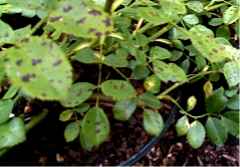
Black Spot on a rose |

Black Spot on a rose |
Four or five years back, I had the pleasure of being asked to teach the "DIseases" module of the Virginia Cooperative Extension Master Gardener course for our local region. The first thing that went through my mind was, "How in the world could I possibly spend 3 hours talking about diseases!" This portion of the course also covered diagnostics of plant problems, an essential part of diseases. Needless to say, I ran out of time. For this reason, I have avoided writing a column on diseases, as we could be here all day. Now that customers are dragging in infected leaves and branches as well as chunks of sod from the lawn, I feel compelled to briefly address the subject. "You can run, but you cannot hide."
Rule one in diagnosing a plant problem is to properly identify the plant. You must then collect as much environmental information as possible, examine the victim, and render a guess regarding the problem. Last week's column pointed out the importance of knowing the characteristics of your plant.
Diseases often stem from fungal spores or bacteria, and are prevalent in nature (the environment of the plant). The disease needs a host and optimum conditions. Just as we drink orange juice to stay healthy and ward off a cold, healthy plants are less susceptible to diseases. One of the best measures to maintain the health of a plant is to plant it in a place where it will be happy. A miserable plant means high susceptibility to problems.
Generalized disease symptoms include:
Blights - sudden death of twigs, foliage, flowers.
Cankers - Dead places on bark and cortex of stems; often discolored and
raised or sunken.
Galls - Abnormal, localized swellings on leaf, stem, or root tissue.
Rots - General decomposition and destruction of tissue.
Necrosis - Death of tissue.
Spots - Circular or irregular lesions on above-ground tissue.
(See footnotes).
Let me say that temperature, moisture, and stress cause a disease to thrive. This is why problems crop up in periods of frequent rainfall in late spring / summer. Fungal spores actually penetrate the wall of plant foliage, break into the plant, rearrange the furniture, leave dirty socks lying around, and eat everything in the fridge. In the process of this pandemonium, they destroy the cells in the plant, causing sickness and, at times, death. This is not to say that diseases are always lethal. While we often walk around with a nagging cold which surely is not good for us, the condition is usually not our demise. Often, a plant left untreated will do just fine when environmental conditions improve, affording the plant enough strength and determination to evict (or at least control) its invaders.
What we are seeing at the store is a lot of powdery mildew on dogwoods and upright phlox, leaf spot on Photina, crown rot on hostas, pythium in newly seeded lawns, cedar apple rust on developing apples, etc. One should ask them self lots of questions regarding the environment of the plant, keep copious notes on the problem, and monitor the situation carefully. If need be, treat the plant with a fungicide. Often, a disease cannot be treated with a fungicide. In closing, let me say that I learned a few years ago, while treating a totally brown and parched lawn, "You can cure the sick, but you cannot raise the dead", so don't ignore a plant which shows signs of stress. See you next week.
Andy Lynn
The 6 disease symptoms
are derived from "The Virginia Master Gardener Handbook"